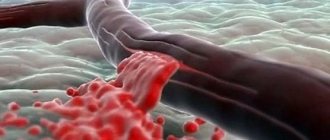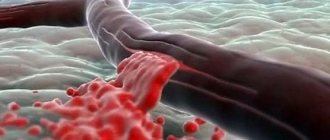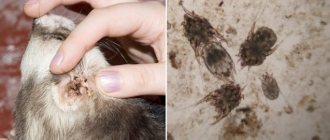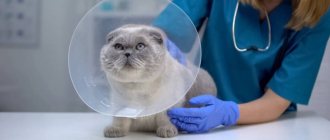Causes of hemoperitoneum in cats Signs Diagnosis Treatment Home care
Hemoperitoneum (hemoabdomen) is an accumulation of blood in the abdominal cavity, occurs after intra-abdominal bleeding, when blood accumulates in the space between the abdominal wall and the abdominal organs.
Hemoperitoneum is a potentially life-threatening situation. The abdominal cavity is a large space that can hold a significant amount of blood. At the same time, the abdominal muscles are stretched, and an increase in abdominal volume becomes obvious. An enlarged abdomen can cause discomfort or pain, leading to agitation and stress, and pressure on the diaphragm can interfere with breathing.
Rapid loss of blood into the abdominal cavity results in decreased tissue perfusion (blood supply) and a drop in blood pressure, which can cause shock. Loss of blood leads to anemia, mucous membranes turn pale. If such a patient is not given immediate veterinary attention, rapid blood loss can lead to death. However, gradual blood loss is more common, which allows the animal to receive the necessary help.
Chronic blood loss occurs more slowly and symptoms are less severe. With slow blood loss, some of the free blood from the abdominal cavity may be absorbed; thus, the animal will have a small volume of blood in the abdominal cavity. This situation may not seem like an emergency, but the animals have a severe primary illness. In these cases, it is extremely important to notice hemoperitoneum and make the correct diagnosis.
If the cat has normal blood clotting parameters, then bleeding into the abdominal cavity can stop on its own: blood clots form, which stop the bleeding. Sometimes cats lose consciousness due to sudden blood loss, and then spontaneously recover due to the body's compensatory abilities. Such animals may have periods of weakness followed by normal well-being. If blood clots are displaced (for example, when an animal moves), bleeding into the abdominal cavity may resume.
Causes of hemoperitoneum in cats
Traumatic injury – most often causes bleeding into the abdominal cavity, especially in cats with outdoor access. Depending on the size and number of damaged vessels, the degree and rate of blood loss will vary.
Abdominal neoplasms - can rupture and cause massive bleeding, bleed slowly, or grow into a blood vessel and disrupt its integrity. Tumors are more common in older cats.
Hematomas are confined collections of blood that can rupture and bleed. Hematomas usually develop due to vascular damage due to trauma.
Coagulopathy - bleeding disorders, in addition to hemoperitoneum, can cause bleeding in other places. Usually such bleeding does not stop on its own. Coagulopathies often occur due to poisoning by rat poison, but can also be caused by other reasons.
Depending on the rate and extent of blood loss, hemoperitoneum may represent an emergency.
Causes of bloody impurities in urine
A number of reasons can provoke inappropriate impurities:
- Bacterial infections;
- Helminthic infestations affecting the kidneys and bladder;
- Organ damage due to trauma;
- Poisoning;
- Heart diseases;
- Oncology;
Of course, in all unclear situations when it comes to a pet and its health, it is better to immediately consult a specialist. But there are times when it is simply not physically possible to quickly deliver a patient to a veterinary clinic. So what should you do if there is blood in your cat’s urine?
We recommend the article: Why do sores appear on a cat’s face?
Basic actions:
- Provide the animal with a quiet stay in a cozy, dry place where no one will disturb or tug at it.
- Place clean water nearby so that the cat does not have to walk far to quench its thirst.
- Feed with liquid food.
- To disinfect the urinary tract, give your pet decoctions of parsley or bearberry.
- To eliminate inflammatory processes, decoctions of horsetail and juniper will help well.
- Under no circumstances should you start giving your animal antibiotics or other medications before consulting with a specialist.
- If bleeding is heavy, ice should be used as a cold compress on the lower abdomen or sacrum.
Diagnostics
A history and physical examination are essential for a quick and accurate diagnosis. In the case of a critical condition of an animal, its life depends on the speed of diagnosis and initiation of adequate treatment.
Your veterinarian may also recommend:
- X-ray of the abdominal cavity - allows you to detect the presence of free fluid in the abdominal cavity, as well as massive formations: tumors and hematomas.
- Puncture of the abdomen using a needle and syringe to obtain a sample of fluid for testing - with hemoperitoneum, the fluid will look like blood but will not clot.
- Analysis of the resulting sample - with hemoperitoneum, the hematocrit of the liquid will be close to the hematocrit of the patient's blood.
- A complete blood test will allow you to assess the degree of anemia due to blood loss, as well as understand whether the bleeding is acute or chronic.
If necessary, additional research is carried out:
- A biochemical blood test will allow you to assess the degree of damage to internal organs. Animals with recent trauma typically have elevated liver enzymes. It is also important to assess renal function.
- Coagulogram - allows you to identify blood clotting disorders.
- Ultrasound examination of the abdominal cavity - allows you to identify the presence of neoplasms in the abdominal cavity.
- CT or MRI - allow you to visualize tumors that are not accessible to ultrasound.
Before carrying out a full diagnosis, the animal’s condition must always be stabilized!
Endometritis
Inflammation of the uterine mucosa. The cause is genital infections. Animals walking on the street, young cats under 3 years of age, when using hormonal drugs for estrus, an unbalanced diet, difficult childbirth, and a hereditary tendency are at risk.
© shutterstock
The disease is considered in acute or acquired form. Let's look at the symptoms. In the acquired form, symptoms are mild. The pet looks healthy in appearance, but often licks itself, so the cat’s blood from the uterus is not visible. The danger is that this form can become purulent. This is due to increased accumulation of secretions due to thickening of the uterine mucosa. The secretion is a favorable environment for the development of infections. Characterized by copious discharge and increased body temperature. Urgent medical assistance is required.
Symptoms in acute form:
- temperature increase;
- loss of appetite;
- copious discharge from the genital opening;
- often arches his back and assumes a posture for urination;
- abdominal enlargement;
- the external genitalia are inflamed.
At an early stage, antibiotics and antimicrobials are used. In case of purulent form, sterilization is carried out. To increase the body's defenses, immunomodulators are prescribed.
Treatment
Treatment depends on the cause of the disease and the clinical condition of the cat. If the animal is critically ill, symptomatic treatment should be started before diagnosis is made.
Therapy may include:
- Abdominal puncture (if pressure on the diaphragm prevents breathing).
- Intravenous infusion - intravenous administration of solutions helps maintain blood pressure and improve organ and tissue perfusion, which is critical for animals in shock.
- Blood transfusion – for severe anemia.
- Pressure bandage on the abdomen - a bandage increases intra-abdominal pressure, which helps slow down or stop bleeding.
- Oxygen therapy is necessary for animals with large blood loss, especially in the early stages of treatment.
- Pain relief – reduces stress and improves the condition of patients.
- The purpose of vitamin K is for coagulopathies caused by poisoning with rat poison and other anticoagulants.
- Emergency diagnostic surgery - if there is a tumor in the abdominal cavity, or bleeding (with normal blood clotting) does not stop, despite treatment.
So what do we see on the outside when internal bleeding occurs?
There are some common signs observed with any bleeding:
- pallor
Constant bleeding can cause your pet to have a low red blood cell count and appear “bleeded out.” You may examine the mucous membranes, including the gums and the conjunctival tissue around the eyes.
When healthy, these tissues have a beautiful pink color. With internal bleeding, these membranes become pale, soft gray to white. You may notice a loss of visible blood vessels in the whites of the eyes, and your cat's beautiful pink nose may turn white.
- tachycardia and rapid breathing
If blood volume decreases, the heart has to beat faster to try to deliver it to all the organs of the body. This can result in a weak, rapid heart rate.
Your cat's normal heart rate should be between 160 and 240 beats per minute.
At the same time, increased work of the lungs occurs, which transfer oxygen to the body tissues. As tissues become starved of oxygen, the brain tells the lungs to breathe faster to deliver oxygen from the inhaled air at a faster rate.
The normal resting respiratory rate for cats is 35 breaths per minute or less.
- collapse (death)
If circulation is impaired to such an extent that blood can no longer be delivered throughout the body, for example to the brain or lungs, then the function of these organs stops.
Call a veterinarian Moscow
+7(495)162-70-70
Home care
Hemoperitoneum can be an emergency and veterinary attention should be sought as soon as possible. Minimize stress until you can get to the veterinary clinic, keep the animal warm, and ensure peace. If traumatic injury is suspected, be careful when moving your pet as spinal injuries or fractures may be present.
(c) Veterinary center for the treatment and rehabilitation of animals “Zoostatus”. Varshavskoe highway, 125 building 1. tel. 8 (499) 372-27-37
Fungal, viral and bacterial infections
Symptomatic manifestations of infections, especially fungal infections - Candida albicans and viruses, usually affect people with weakened immune systems, but can also occur in healthy people with a temporary decrease in immunity.
Candidiasis can be a systemic disease and in special cases it is very difficult to treat
Prompt treatment is important because the infection is actually dangerous and can lead to debilitation and even death. Lesions occur in the mouth, most often in the form of atrophy and thrush
As for the tongue, it is covered with a white, lumpy coating that can spread to the roof of the mouth, throat and esophagus.
Candidiasis also causes glossitis and geographic tongue. The disease may be accompanied by ulcerations in the mouth, erosions and cracks in the corners of the mouth. All of the above symptoms cause a change in pain intensity. Sometimes dysgeusia occurs - taste disturbances
When diagnosing pathology, it is important to include hairy leukoplakia in the differential diagnosis.
Herpes viruses are another factor that affects the tongue. They cause, among other things: chickenpox, herpes zoster, herpes and cytomegaly. The ease of transmission and infection leads to high morbidity rates. The infection can affect different parts of the body: the head and neck are most often affected by HSV-1, and the urogenital system - by HSV-2.
Most infections are asymptomatic. The rest usually appear as tiny blisters that cover not only the tongue, but the entire mouth. They can gather in small groups, and when they burst, they form shallow ulcers.
Herpetic stomatitis
The most common and well-known diseases are caused by bacteria - streptococci from group A. One of them is scarlet fever - a childhood disease. In addition to other manifestations on the body, characteristic changes in the tongue can be noted. First, it is clothed, that is, covered with a white coating. Then the nipples on the tongue become inflamed and become intensely red. The general appearance of the tongue at this stage can be described as strawberry or raspberry.
How and how to treat acute thrombophlebitis
Treatment of thrombophlebitis will depend on the stage at which the disease is. There is conservative treatment or active surgical tactics. Which method the doctor chooses depends on his knowledge, qualifications and experience in treating acute thromboleptitis. Our clinic provides comprehensive treatment for acute thrombophlebitis:
- constant wearing of compression stockings;
- anti-inflammatory drugs and ointments;
- blood thinners;
- laser treatment;
- RFA treatment.
Treatment of acute thrombophlebitis with laser in our clinic
When all these methods are used simultaneously, we get good results, and patients go about their usual activities, without interrupting work and family. We often come across patients who use traditional methods of treating thrombophlebitis. These methods will not help eliminate thrombophlebitis of the lower extremities, the symptoms of which are very unpleasant, but will only aggravate the patient’s situation.
What kind of bleeding can there be?
Although the cause of blood loss is always a violation of the integrity of the vessel wall, the bleeding itself can be very different.
Table: classification of bleeding
| Classification sign | Types of bleeding |
| Type of damaged vessel |
|
| Time of bleeding |
|
| Direction of blood flow |
|
With external bleeding, blood flows freely outward
At the same time, no matter how the blood loss occurs (drop by drop, in a thin stream or in a pulsating fountain), external bleeding is almost always clearly visible, while internal bleeding is never visible. And this makes internal bleeding especially dangerous.











